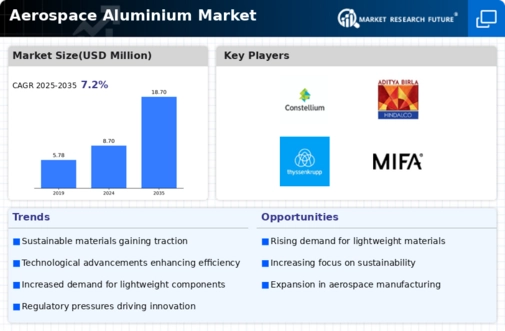Aerospace Aluminium Market is characterized by a high level of competition, with many players emerging for market share. The top 10 companies in the market account for a significant market share of Aerospace Aluminium Market. The competitive landscape of Aerospace Aluminium Market is dynamic, with companies constantly innovating and expanding their product offerings. Despite the challenges, several factors are driving growth in the aerospace aluminium market, including a rising demand for lightweight materials and the expansion of the commercial aviation industry.
The market is expected to experience significant growth in the coming years, driven by emerging opportunities in aerospace manufacturing within various markets.
The market is benefiting from the development of new technologies. The key players in the Aerospace Aluminium Market include Alcoa Corporation, Constellium, Kaiser Aluminium, Hindalco Industries Ltd., Thyssenkrupp, AMG (Advanced Metallurgical Group), VSMPO-AVISMA Corporation, Aluminium Precision Products, Inc., Mifa Aluminium, Wuxi HENG TAI AEROSPACE Science and Technology Co., Ltd. and UACJ Corporation. These companies compete based on product quality, innovation, price, customer service, and market share. Companies also engage in various strategic initiatives, such as mergers and acquisitions, new product launches, partnerships, joint ventures, and expansions, to enhance their market position and expand their product portfolio.
Companies are also focusing on developing new and innovative products that meet the specific needs of their customers. Companies will need to continue to innovate and expand their product offerings to remain competitive. For instance, on 3 June 2020, Constellium SE signed a multi-year contract with Airbus. The new 10-year agreement supports all Airbus’ programs. Under this agreement, Constellium will supply Airbus with a broad range of advanced aluminium rolled and extruded products, including wing skin panels, sheets for fuselage panels, and rectangular and pre-machined plates for structural components.
This agreement strengthens the long-standing partnership between Constellium and Airbus and further demonstrates the leadership role that Constellium holds in the market for advanced aluminium products and solutions.
Alcoa Corporation: Alcoa is recognized as a global leader in the production of bauxite, alumina, and aluminium products, with a vision focused on reinventing the aluminium industry for a sustainable future. The company emphasizes a values-based approach that includes integrity, operational excellence, care for people, and courageous leadership. Its purpose is articulated as turning raw potential into real progress. Since pioneering the process that made aluminium both affordable and essential to modern life, Alcoa's skilled workforce has developed innovative solutions and best practices that enhance efficiency, safety, sustainability, and community strength in the regions where they operate.
Currently, Alcoa maintains operations or ownership interests in 27 locations across nine countries, with its global headquarters situated in Pittsburgh, Pennsylvania, USA. The company’s common stock is listed on the New York Stock Exchange, and its business is structured into two segments: Alumina and Aluminium. The Alumina segment encompasses global bauxite mines and alumina refineries. Alcoa holds significant mining operations in Australia and South America, positioning itself as one of the world’s leading bauxite miners. Additionally, it operates one of the largest alumina businesses outside of China, with refineries located on three continents.
The Aluminium segment includes aluminium smelting and casting operations, along with the majority of the company's energy assets.
Constellium: Constellium is recognized as a global leader in the development and manufacturing of high value-added aluminium products and solutions, as well as in aluminium recycling. The company employs approximately 12,500 people worldwide and operates 25 manufacturing sites across Europe, North America, and China, in addition to maintaining three R&D centers. Headquartered in Paris, Constellium also has corporate offices in Baltimore and Zurich. The company is organized into three primary business units: Aerospace and Transportation (A&T), Packaging and Automotive Rolled Products (P&ARP), and Automotive Structures and Industry (AS&I).
Constellium focuses on sustainably transforming aluminium into value-added products, leveraging its intrinsic qualities—lightweight, strong, and recyclable. These solutions enable customers, including canmakers, car manufacturers, and aircraft manufacturers, to create lighter, safer, and cleaner products for everyday use. With a commitment to continuous innovation, Constellium aims to generate greater value for its partners while contributing to a more sustainable future. Additionally, the company prioritizes aluminium recycling to fully realize its circularity and minimize its environmental footprint.















Leave a Comment